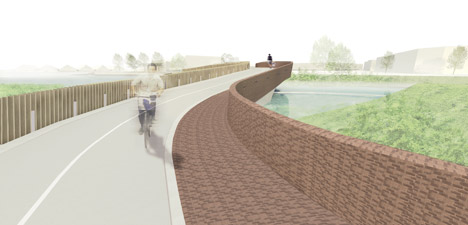NEXT Architects' bat-friendly bridge to have winter roosts built into its concrete structure
The Vlotwateringbrug by NEXT Architects will span a river that forms an important natural pathway for the local bat population, and provide shelter for the mammals with a series of covered roosting spots.
Clad with a screen of wooden slats on one side and bricks on the other, the bridge is designed by NEXT Architects to span a 25-metre gap between the banks of the Vlotwatering river in Monster, a town in the Dutch province of South Holland.
The bridge's curving form – designed to offer a place to pause and take in views of the surrounding area – means that its total length will actually be 70 metres long. It will be seven metres wide and provide a new crossing for pedestrians and cyclists.

The river is an important route for the bats, which cross the water to catch small insects, so the architects responded to the client's brief for an "eco-friendly" bridge by designing a structure for both people and the animals.
"One of the noticeable things of the area was that there were already different types of bats flying the route over the water – throughout the winter periods they hide in world war two concrete bunkers around the area, for the moderate climate," NEXT Architects co-founder Bart Reuser told Dezeen.
"This became our inspiration, we thought we might be able to design the foundation (bridgehead) equating the environmental qualities of a bunker," he said.

To create a bridge that could offer safe roosting spots for different species of bat – particularly during the hibernation period in winter – the architects have to add extra mass to ensure its temperature could remain relatively stable.
They chose to use concrete for the main structure, and will create hidden entrances to roosting areas on the underside.

"The basics of designing for bats does not differ much from designing for humans," said Reuser. "It is important that the temperature doesn't drop too far, this is possible by using lots of mass that equalises temperature throughout the day and the seasons."
"Bridges are heavy structures by themselves so with small adaptations we can make them suitable as bat places. In our case we needed to thicken the concrete foundation, walls and decks to an average of 0.75 metres."
Three specific elements of the bridge were designed for the bats – on the north side, an abutment accommodates winter roosting, while the deck and the brick balustrade include openings to facilitate summer roosting.

"For safety you need to protect the bats against their natural enemies, which are predators like cats and owls, but mainly humans," said Reuser. "It is most important to make entrances for their stays that are very small, hardly visible or cannot be reached by their natural enemies."
The architects hope that a large colony of various species will be encouraged to grow around the bridge.
During the design process, they consulted Herman Limpen from the Netherland's Mammal Society, one of the leading experts in bat behaviour.
"There is no other bridge like it that is specifically designed to house bats," said Limpens.

The bridge is currently under construction and is due to be completed in August 2015.
It forms part of a 21-hectare waterway project called the Poelzone that aims to turn the banks of the river between 's-Gravenzande, Naaldwijk and Monster into a public recreation zone as well as create new habitats for indigenous wildlife.
This project is being overseen by landscape design studio LOLA Landscape. The bridge by Next Architects marks the beginning of the Poelzone's route.
The wooden cladding of the bridge was chosen to reflect materials being used elsewhere in the park.

